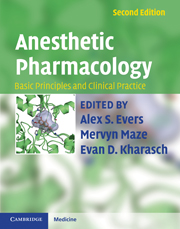17 results
Chapter 10 - Comorbidities and Postoperative Neurocognitive Disorder
- from Section 2 - Pathophysiology of the Perioperative Neurocognitive Disorders
-
-
- Book:
- The Perioperative Neurocognitive Disorders
- Published online:
- 11 April 2019
- Print publication:
- 28 March 2019, pp 115-122
-
- Chapter
- Export citation
Contributors
-
-
- Book:
- Brain Disorders in Critical Illness
- Published online:
- 05 October 2013
- Print publication:
- 19 September 2013, pp viii-xii
-
- Chapter
- Export citation
Chapter 9 - Neurology of sleep and sleep disorders
- from Section 2 - Behavioral Neurology in the ICU
-
-
- Book:
- Brain Disorders in Critical Illness
- Published online:
- 05 October 2013
- Print publication:
- 19 September 2013, pp 76-83
-
- Chapter
- Export citation
18 - Novel neuroprotective therapies
- from Section 3 - The future
-
-
- Book:
- Neonatal Neural Rescue
- Published online:
- 05 March 2013
- Print publication:
- 04 April 2013, pp 195-207
-
- Chapter
- Export citation
Section 4 - Clinical applications: evidence-based anesthesia practice
-
- Book:
- Anesthetic Pharmacology
- Published online:
- 11 April 2011
- Print publication:
- 10 March 2011, pp 987-1006
-
- Chapter
- Export citation
Anesthetic Pharmacology - Half title page
-
- Book:
- Anesthetic Pharmacology
- Published online:
- 11 April 2011
- Print publication:
- 10 March 2011, pp i-ii
-
- Chapter
- Export citation
Contributors
-
-
- Book:
- Anesthetic Pharmacology
- Published online:
- 11 April 2011
- Print publication:
- 10 March 2011, pp viii-xiv
-
- Chapter
- Export citation
Section 2 - Physiologic substrates of drug action
-
- Book:
- Anesthetic Pharmacology
- Published online:
- 11 April 2011
- Print publication:
- 10 March 2011, pp 177-191
-
- Chapter
- Export citation
Contents
-
- Book:
- Anesthetic Pharmacology
- Published online:
- 11 April 2011
- Print publication:
- 10 March 2011, pp v-vii
-
- Chapter
- Export citation
Preface
-
- Book:
- Anesthetic Pharmacology
- Published online:
- 11 April 2011
- Print publication:
- 10 March 2011, pp xv-xvi
-
- Chapter
- Export citation
Section 1 - Principles of drug action
-
- Book:
- Anesthetic Pharmacology
- Published online:
- 11 April 2011
- Print publication:
- 10 March 2011, pp 1-16
-
- Chapter
- Export citation
Anesthetic Pharmacology - Title page
-
-
- Book:
- Anesthetic Pharmacology
- Published online:
- 11 April 2011
- Print publication:
- 10 March 2011, pp iii-iii
-
- Chapter
- Export citation
Section 3 - Essential drugs in anesthetic practice
-
- Book:
- Anesthetic Pharmacology
- Published online:
- 11 April 2011
- Print publication:
- 10 March 2011, pp 359-384
-
- Chapter
- Export citation
Copyright page
-
- Book:
- Anesthetic Pharmacology
- Published online:
- 11 April 2011
- Print publication:
- 10 March 2011, pp iv-iv
-
- Chapter
- Export citation
Chapter 30 - Alpha2-agonists and other sedatives and amnestics
-
-
- Book:
- Anesthetic Pharmacology
- Published online:
- 11 April 2011
- Print publication:
- 10 March 2011, pp 478-492
-
- Chapter
- Export citation
Index
-
- Book:
- Anesthetic Pharmacology
- Published online:
- 11 April 2011
- Print publication:
- 10 March 2011, pp 1163-1194
-
- Chapter
- Export citation

Anesthetic Pharmacology
- Basic Principles and Clinical Practice
-
- Published online:
- 11 April 2011
- Print publication:
- 10 March 2011



